WORDS: CAM DONALD PHOTOS: JOSH EVANS
Brave. Innovative. Different. And it works. One man’s dream and perseverance and another bloke’s faith in that man turns an idea to reality
Australians and New Zealanders have a bit of a reputation for ‘thinking outside the square’.
Look across the ditch and a couple of bike names spring immediately to mind. Indeed, Burt Munro and his record-breaking salt racer personify all that is good about the home innovator, and any conversation about Kiwi fabrication and development simply must include super-visionary John Britten and his blindingly fast V-twins.
Locally, we proudly boast engineer-extraordinaire Phil Irving, who took Vincent’s pretty ordinary engine design and turned it into one of the finest powerplants ever to propel a motorcycle, and Ian Drysdale who doggedly held on tightly to his dream of building a fully self-designed, all-Aussie V8-powered motorcycle (page 78).
Back to contemporary times.
It could well be that a new name could join that exalted company. Enter one Ray Van Steenwyk. A lifelong bike lover who is the brains and brawn behind the design of a unique motorcycle. And in the finest tradition, it all takes place in a non-descript shed, in an ordinary part of the Brisbane hills.
So, let’s take a look at the focus of all Ray’s hard work. At first glance the Motoinno TS3 resembles something straight out of a sci-fi thriller. That makes more sense when you learn that Ray has spent more than 30 years in the film and television industry, much of it in the realm of fantasy blockbusters.
AT THE DRAWING BOARD
Trained in art and animation production, he has worked on such films as Mad Max Fury Road, Matrix Reloaded and The Incredible Hulk. All this may seem a little removed from motorcycle design, but working with computer-generated animation supplied Ray with the CAD skills needed to create the intricate hardware you see here.
It’s been a bit of a fury road for Ray himself, suffering a solid bout of chronic fatigue syndrome in the 1990s. The silver lining in that cloud of illness was the chance to uninterruptedly think about the dynamics of the front end of a motorcycle, as we all do when ill.
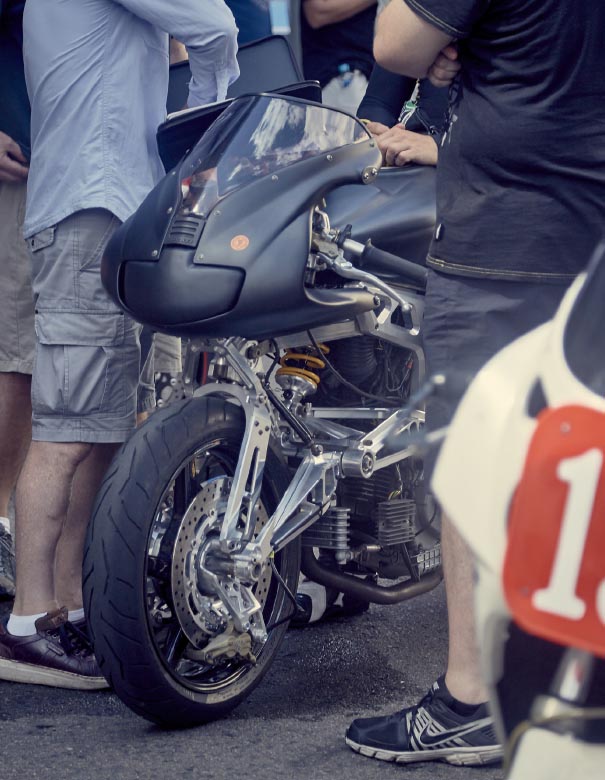


HISTORY LESSONS
‘Conventional’ telescopic fork legs are used in most modern bikes, but that certainly wasn’t the case in years past. The obvious benefit of the telescopic over the older girder-style fork was the ability to ‘dampen’ the suspension action. Even the tele fork is not without its shortcomings, though.
The biggest problem associated with a telescopic fork is oscillation harmonics. This is when shock from the front wheel travels up the long stanchions and into the chassis.
Years after Ray came up with his design he joined forces with good friend Colin Oddy to create Motorcycle Innovation. Colin’s expertise was just what Ray needed – someone with a business mind to help promote the project and raise the much-needed funds.
With the design of the hardware and a business plan completed, the next step was to build a prototype.
A local engineer failed to fabricate the needed parts so Ray had to take matters into his own hands. Bold? Yes. “Time was passing and we were getting lots of excuses but no parts, so I decided to build it myself,” Ray explains.
After years of toil the TS3 was born, a hub-steered chassis design like no other and ready to begin track testing.
The prototype was produced around a 2002 model Ducati 900SS – a sensible choice offering strong torque and spirited acceleration without the outright horsepower that would tie it in knots.
Even with a $50,000 government grant, the boys have still spent more than $300,000 themselves and that’s not counting the seven years of man hours the project has soaked up.
TIME TO THROW A LEG
Once the thing was all together, it was time to see just what they’d come up with, and, after some initial shakedowns, a closed course comparison was done with a Suzuki GSX-R750. The results were promising. On a technical level, the TS3 showed it had some inherent strengths over the proven sweet-handling Suzi.
The TS3 tips the scales a full 30 kilograms lighter than the standard Ducati 900SS, with some weight saved in the exhaust and BST carbon-fibre wheels but most in the chassis itself.
For our test, the front-end geometry was set at 19 degrees of rake and 98mm of trail. The rake can be adjusted between 15 and 24 degrees, with trail increasing or decreasing depending on the degree of rake.
Previous track testing through its full range has indicated that the steering becomes heavier and slower with the steering rake set to its maximum of 24 degrees (increased trail). This is totally opposite to what is accepted as normal from telescopic or alternative steering systems.
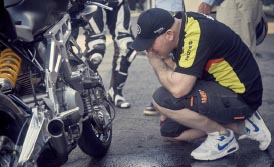
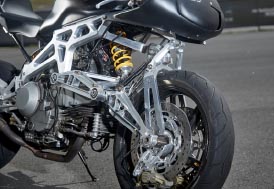
A series of figure eights and quick steering drills left me puzzled yet impressed.
With the complex hardware that makes up the front end, I expected to get a disconnected feeling from the front wheel, but that was not the case.
The next pleasant surprise was the ability to turn tightly, with a steering lock of 54 degrees compared with most bikes having just 38. I could ride in a circle so tight I was only using around twice the wheelbase in area.
During a tight turn that could only be made at slow speed I applied a hard dab of front brake. The handlebars would react as expected by ‘diving’ yet the front wheel didn’t tuck, the bike simply slowed from the brake application and held its course.
Accelerating hard out of pit lane, the 900SS engine pleased the ears with a shortened exhaust.
This, and a Power Commander to tune the EFI, are the only mods made to the otherwise-stock Ducati running gear.
Braking hard into the tightening radius, second gear Turn Two at Sydney Motorsports Park, I used my usual turn-in point, which proved too early and too wide. The TS3 responds so quickly I could move my turn-in point later and even tighter as my turn arc was greatly reduced.
Through fast and indeed slow sections of the track the TS3 remained stable and predictable.
In turn, my confidence quickly grew and I began to up the ante.
Line holding was excellent without any feeling of bump-steer over the rougher sections of Eastern Creek, although I did feel some harshness.
This, to me, felt like a damping issue in the shock itself. A little less compression damping would be my suggestion.
During quick changes of direction, the steering, although feeling very light, did not shudder or wobble.
Some bikes can give you the feeling of riding ‘up and over’ the tyre on change of direction but the TS3 gave none of this.
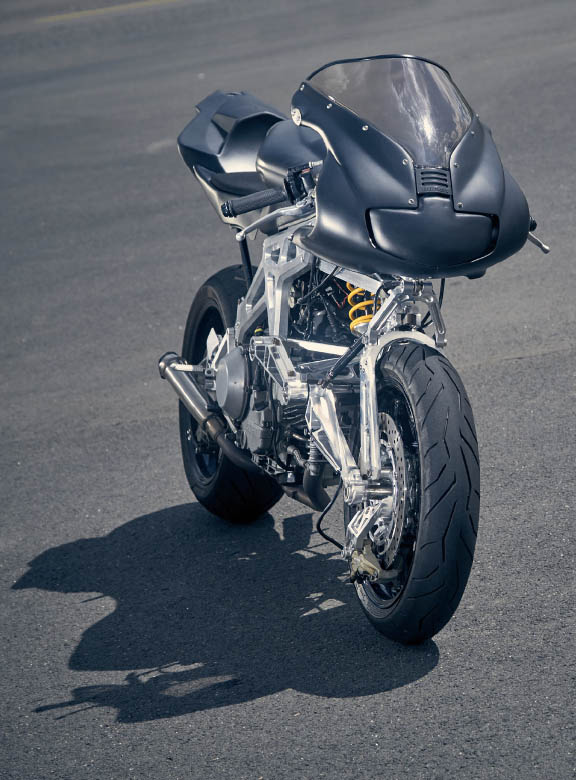
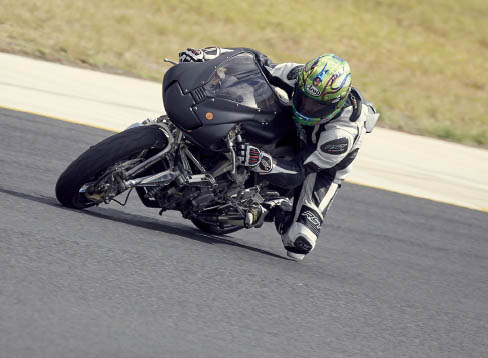
“The bike performed so well in my short time aboard I was struggling to find its limits”
Each lap I was braking deeper into the slower corners, to a point where I would have tucked the front on a conventional bike. The bike performed so well in my short time aboard I was struggling to find its limits.
As you can trail brake so much harder than your conventional riding mind thinks possible, the addition of a proven ABS system would be a great idea to help you learn its limits with a safety net.
SO, WHAT’S THE VERDICT?
I was surprised by how quickly I developed confidence in the front, and the ability to trail brake deeply into a turn.
The reason previous hub-centre-steering bikes haven’t been widely accepted is usually sheeted home to their lack of feel. With this not being an issue with the TS3, I believe it has a big future with so many positives to offer motorcycling in performance and safety.
Ray tells me the next prototype will be powered by a 2014 Ducati Monster 1200 Testastretta engine, although the chassis can be built to suit any conventional bike engine, be it a V-twin or inline four-cylinder.
Ray and Colin reckon the best way to prove their concept is on the racetrack and, as a consequence, are exploring a Moto2 build using a TS3 chassis. As Moto2 uses a control engine, it’s the ideal platform to showcase the front-end setup and its handling capabilities.
Taking on the world’s best with something so different is a big call but, judging from what I’ve seen, the TS3 could be a surprise package. •
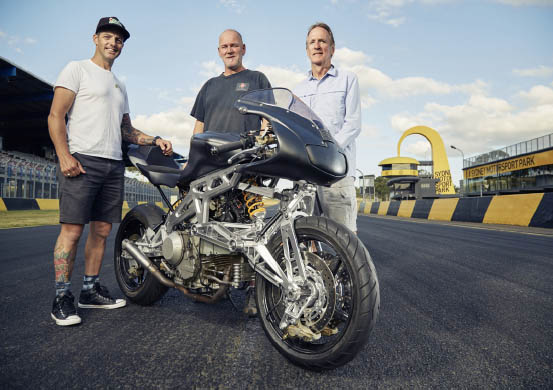
SPECS: Motoinno TS3
ENGINE
TYPE: Air-cooled, two-valves per cylinder, V-twin
CAPACITY: 904cc
BORE & STROKE: 92 X 68mm COMPRESSION RATIO: 9.2:1 FUEL SYSTEM: Weber Marelli electronic fuel injection
TRANSMISSION
TYPE: Six-speed, constant mesh FINAL DRIVE: Chain
CHASSIS &
RUNNING GEAR
FRAME TYPE: TS3 frame and swingarms from billet aluminium FRONT AND REAR SUSPENSION: Afco T2 adjustable shocks, compression/rebound adjustable, RAKE: 15 -24 degrees, incrementally adjustable
TRAIL: 98mm at 19 degree rake, variable to suit from minus 100
(full pro-dive) through to 0 (no dive) to positive 100mm (full
anti-dive)
FRONT BRAKE: Twin 320mm discs, Brembo four-piston calipers REAR BRAKE: Single 220mm disc, twin-piston caliper
DIMENSIONS
& CAPACITIES
DRY WEIGHT: 161kg
SEAT HEIGHT: 820mm WHEELBASE: 1394mm
WHEELS & TYRES
FRONT: BST carbon-fibre with Pirelli Diablo Rosso II 120/70-17 REAR: BST carbon-fibre with Pirelli Diablo Rosso II 180/60-17
Many thanks to Ray Van Steenwyk and Colin Oddy for taking time out and entrusting us with their baby.
